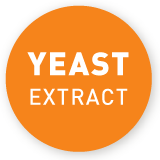Yeast extract is made from brewer’s or baker’s yeast and has been used as a natural ingredient for a wide variety of foodstuffs for over 100 years. To make yeast extract, sugar is added to the fresh yeast – just like you do when baking. This way the yeast can optimally multiply at a temperature of 30 degrees Celsius and with a sufficient supply of oxygen. The result is a viscous, creamy yeast mass. The yeast extract is then obtained using so-called autolysis:
Enzymes break down the yeast protein into its components: amino acids and peptides. The enzymes also allow the cell walls to become permeable so that amino acids, peptides, minerals and vitamins leave the yeast cell and mix with the surrounding liquid. The resulting mixture already tastes like a savoury bouillon.
A similar process is performed when producing the traditional condiment soy sauce: Soybeans are mixed with rice or wheat grains. By enriching the mixture with specific microorganisms like yeast, a mash emerges and salt and water are added. The blend matures in containers and enzymes split the soy proteins into the individual amino acids. This enzymatic reaction characterizes – just like in the case of yeast extract – the taste of the emerging condiment decisively.
To finish the yeast extract production process after the autolysis, the yeast cell walls are removed mechanically with a centrifuge. What remains is yeast extract: a liquid that has an amino acid profile very similar to that of a cooked meat stock and that still contains valuable vitamins and minerals. In simple terms: Yeast extract contains all the natural components of the yeast cell without the surrounding cell wall.



